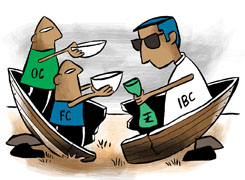38 Year Old Seeking Advice: How to Plan for Education and Retirement with 1.5Cr Home, 60L FD, and 20L Gold?
Ramalingam Kalirajan |10899 Answers |Ask -Follow
Mutual Funds, Financial Planning Expert - Answered on Feb 03, 2025
He has an MBA in finance from the University of Madras and is a certified financial planner.
He is the director and chief financial planner at Holistic Investment, a Chennai-based firm that offers financial planning and wealth management advice.... more

Hi i am 38 years old, my home worth 1.5cr, fd 60L, gold of 20Li have two kids of 10&4 years, how I can plan for their education and my retirement at50 and my salary ll be one Lakh
You are 38 years old with a goal to retire at 50.
Your home is worth Rs. 1.5 crores.
You have Rs. 60 lakhs in fixed deposits.
You own Rs. 20 lakhs worth of gold.
Your monthly salary is Rs. 1 lakh.
You have two children aged 10 and 4.
Your focus is on education planning and retirement planning.
This is a strong starting point. You’ve managed your finances well so far.
Setting Clear Financial Goals
Before planning, we need clarity on two major goals:
Children’s Education: Estimate costs for higher education. Costs are rising due to inflation.
Retirement at 50: You’ll need to maintain your lifestyle without active income.
These goals will guide your investment and savings strategy.
Estimating the Future Cost of Children’s Education
For your 10-year-old, higher education is about 8 years away.
For your 4-year-old, it's around 14 years away.
Considering inflation, education costs may double or even triple.
A professional degree might cost Rs. 30-50 lakhs in the future.
Plan with this in mind to avoid surprises later.
Planning for Retirement at 50
You plan to retire in 12 years.
After retirement, your expenses will continue for at least 30-35 years.
This requires a steady income without depending on a job.
You need a large corpus to support your lifestyle.
Managing Fixed Deposits Effectively
Rs. 60 lakhs in FDs is good, but FDs offer low returns after tax.
Inflation can reduce the real value of FD returns over time.
Gradually shift some FD amounts to mutual funds for better growth.
This ensures your money grows faster than inflation.
Gold as an Investment
Rs. 20 lakhs in gold adds diversification to your portfolio.
However, gold doesn’t provide regular income or high growth.
Consider keeping some gold for emergencies or gifting.
For wealth creation, focus more on financial instruments like mutual funds.
Building an Education Fund for Your Children
Start dedicated SIPs for both children in equity mutual funds.
Equity can provide higher returns over long periods.
For the 10-year-old, choose balanced funds to reduce risk as the goal nears.
For the 4-year-old, focus more on equity-oriented funds for higher growth.
Increase SIP amounts whenever your income rises.
Review and adjust the SIPs regularly.
Retirement Planning: Creating a Strong Corpus
Start SIPs dedicated to your retirement goal.
Focus on diversified equity mutual funds for growth.
Increase your SIPs yearly as your salary grows.
Invest any bonuses or extra income into these funds.
Closer to retirement, shift some funds to safer options like debt funds.
This reduces risk as you near retirement.
Insurance Planning for Risk Protection
Review your life insurance coverage.
Ensure you have enough cover to protect your family’s future.
Term insurance is cost-effective and provides high cover.
Also, have health insurance separate from your employer’s policy.
This ensures continuous coverage even after retirement.
Managing Expenses for Better Savings
Your salary is Rs. 1 lakh per month.
Track your expenses to identify saving opportunities.
Aim to save at least 30-40% of your income.
Reduce unnecessary expenses to increase your investment amount.
Small changes can lead to big savings over time.
Creating an Emergency Fund
Set aside 6-12 months of expenses as an emergency fund.
Keep this in a liquid fund or savings account for quick access.
This protects your investments from unexpected withdrawals.
An emergency fund provides financial security.
Surrendering LIC or Investment-Linked Insurance (If Applicable)
If you have LIC or ULIP policies, review their returns.
Such policies often offer low returns compared to mutual funds.
Consider surrendering them if they’re not beneficial.
Reinvest the amount in mutual funds for better growth.
Consult with a Certified Financial Planner before making changes.
Tax Planning for Maximum Savings
Use Section 80C to save tax through PF, PPF, or ELSS mutual funds.
Invest in NPS for additional tax benefits under Section 80CCD(1B).
Claim deductions for health insurance premiums under Section 80D.
Efficient tax planning increases your investable surplus.
How to Allocate Your Investments
Education Fund: Start SIPs based on each child’s education timeline.
Retirement Fund: Invest separately for retirement with a long-term focus.
Emergency Fund: Build and maintain this for unexpected needs.
Gold: Keep a portion but focus more on financial investments.
Diversification helps manage risk and improve returns.
Reviewing and Adjusting Your Financial Plan
Review your financial plan yearly.
Adjust SIP amounts based on income changes.
Rebalance your portfolio to maintain the right mix of equity and debt.
Regular reviews keep your goals on track.
Staying Disciplined with Investments
Avoid withdrawing from your investments unless it’s for the intended goal.
Don’t react to short-term market fluctuations.
Focus on long-term growth and stay invested.
Discipline is key to wealth creation.
Final Insights
You’ve built a solid financial base.
Focus on structured investments for your children’s education and your retirement.
Mutual funds through SIPs offer growth and flexibility.
Review your plan regularly and stay disciplined.
This approach will help you achieve financial freedom by 50.
Best Regards,
K. Ramalingam, MBA, CFP,
Chief Financial Planner,
www.holisticinvestment.in
https://www.youtube.com/@HolisticInvestment
You may like to see similar questions and answers below
Ramalingam Kalirajan |10899 Answers |Ask -Follow
Mutual Funds, Financial Planning Expert - Answered on Jul 19, 2024
Ramalingam Kalirajan |10899 Answers |Ask -Follow
Mutual Funds, Financial Planning Expert - Answered on Jun 26, 2025
Ramalingam Kalirajan |10899 Answers |Ask -Follow
Mutual Funds, Financial Planning Expert - Answered on Aug 04, 2025
Sunil Lala | Answer |Ask -Follow
Financial Planner - Answered on Jul 15, 2025
Naveenn Kummar |235 Answers |Ask -Follow
Financial Planner, MF, Insurance Expert - Answered on Sep 18, 2025
Samraat Jadhav |2511 Answers |Ask -Follow
Stock Market Expert - Answered on Dec 17, 2025
Ravi Mittal |678 Answers |Ask -Follow
Dating, Relationships Expert - Answered on Dec 17, 2025
Reetika Sharma |426 Answers |Ask -Follow
Financial Planner, MF and Insurance Expert - Answered on Dec 17, 2025
Purshotam Lal |68 Answers |Ask -Follow
Financial Planner, MF and Insurance Expert - Answered on Dec 17, 2025
Ramalingam Kalirajan |10899 Answers |Ask -Follow
Mutual Funds, Financial Planning Expert - Answered on Dec 17, 2025
Ramalingam Kalirajan |10899 Answers |Ask -Follow
Mutual Funds, Financial Planning Expert - Answered on Dec 17, 2025
Ramalingam Kalirajan |10899 Answers |Ask -Follow
Mutual Funds, Financial Planning Expert - Answered on Dec 17, 2025
Ramalingam Kalirajan |10899 Answers |Ask -Follow
Mutual Funds, Financial Planning Expert - Answered on Dec 17, 2025
Ramalingam Kalirajan |10899 Answers |Ask -Follow
Mutual Funds, Financial Planning Expert - Answered on Dec 17, 2025
Mayank Chandel |2576 Answers |Ask -Follow
IIT-JEE, NEET-UG, SAT, CLAT, CA, CS Exam Expert - Answered on Dec 17, 2025



























